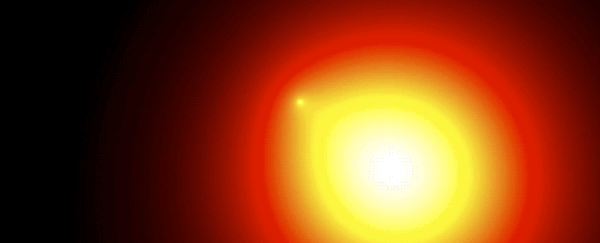Astronomers have been watching a nearby pulsar with a strange halo around it. That pulsar might answer a question that's puzzled astronomers for some time.
The pulsar is named Geminga, and it's one of the nearest pulsars to Earth, about 800 light-years away in the constellation Gemini. Not only is it close to Earth, but Geminga is also very bright in gamma rays.
The halo itself is invisible to our eyes, obviously, since it's in the gamma wavelengths. (NASA's Fermi Gamma-ray Space Telescope discovered it.) But it's large, covering as much of the sky as 40 full Moons.
The halo might be responsible for some goings-on in our own neighborhood: there's an abundance of anti-matter near Earth, and its presence has puzzled scientists for a decade.
"Our analysis suggests that this same pulsar could be responsible for a decade-long puzzle about why one type of cosmic particle is unusually abundant near Earth," said Mattia Di Mauro, an astrophysicist at the Catholic University of America in Washington and NASA's Goddard Space Flight Center in Greenbelt, Maryland.
"These are positrons, the antimatter version of electrons, coming from somewhere beyond the Solar System."
A pulsar is the remnant of a massive star that's gone supernova. Geminga is the result of a supernova explosion about 300,000 years ago in the constellation Gemini.
It's a rotating neutron star that is oriented in a certain way towards Earth, so that its energy is directed toward us like a sweeping lighthouse.
A pulsar is naturally surrounded by a cloud of both electrons and positrons. That's because a neutron star has an intense electromagnetic field, the strongest of any known object.
The super-strong field pulls the particles from the pulsar's surface, and accelerates them to near light-speed.
These fast moving particles, including electrons and their anti-matter counterparts, positrons, are cosmic rays. Since cosmic rays carry an electric charge, they're subject to the effects of magnetic fields.
So by the time cosmic rays reach Earth, astronomers can't pinpoint their source.
During the past decade or so, different observatories and experiments have detected more high energy positrons in our vicinity than expected. NASA's Fermi Gamma-ray Space Telescope, NASA's Alpha Magnetic Spectrometer, and other experiments have all detected them.
Scientists expected that nearby pulsars, including Geminga, were the source. But due to the way those positrons are affected by magnetic fields, it couldn't be proven.
Until 2017.
In that year, the High-Altitude Water Cherenkov Gamma-ray Observatory (HAWC) confirmed what some ground-based detections had found: a small but intense gamma-ray halo around Geminga.
The HAWC detected energies in the halo structure of 5 – 40 TeV, or Tera-electron Volts. That's light with trillions of times more energy than our eyes can see.
Initially, scientists thought that the high energy halo is caused by accelerated electrons and positrons colliding with starlight, which would boost their energy and make them super-bright.
When a charged particle transfers some of its energy to a photon, that's called Inverse-Compton scattering.

But the team using HAWC to observe Geminga and its halo came to a conclusion: those high-energy positrons would only rarely reach Earth, based on the size of the halo. So there had to be another explanation for the abundance of positrons near Earth.
Scientists studying the presence of positrons near Earth didn't cross pulsars off their list yet. And as a close and bright pulsar, Geminga still caught their interest.
Mattia Di Mauro led a small team of scientists studying a decade's worth of Geminga data from Fermi's Large Area Telescope (LAT.) LAT observes lower energy light than HAWC does. Di Mauro is the lead author of a new study presenting these findings.
The study is titled "Detection of a gamma-ray halo around Geminga with the Fermi-LAT data and implications for the positron flux." The paper is published in Physical Review D.
One of the paper's co-authors is Silvia Manconi, a postdoctoral researcher at RWTH Aachen University in Germany. In a press release, Manconi said, "To study the halo, we had to subtract out all other sources of gamma rays, including diffuse light produced by cosmic ray collisions with interstellar gas clouds. We explored the data using 10 different models of interstellar emission."
Once the team subtracted all the other sources of gamma rays in the sky, the data revealed a vast oblong structure; a halo around Geminga. The high energy structure covered 20 degrees in the sky at 20 billion electron volts, and an even larger area at lower energies.
Study co-author Fiorenza Donato is from the Italian National Institute of Nuclear Physics and the University of Turin.
In the press release, Donato said: "Lower-energy particles travel much farther from the pulsar before they run into starlight, transfer part of their energy to it, and boost the light to gamma rays. This is why the gamma-ray emission covers a larger area at lower energies."
"Also, Geminga's halo is elongated partly because of the pulsar's motion through space" Donato explained.
 Geminga's gamma halo over time. (NASA's Goddard Space Flight Center/M. Di Mauro)
Geminga's gamma halo over time. (NASA's Goddard Space Flight Center/M. Di Mauro)
The team compared the LAT data with the HAWC data and concluded that the data-sets matched. They also found that bright, nearby Geminga could be responsible for as much as 20 percent of the high-energy positrons that the AMS-02 experiment observed.
Extrapolating from that to all of the cumulative pulsar emissions in the Milky Way, the team says that pulsars remain the best explanation for the original mystery: the source of all those positrons near Earth.
"Our work demonstrates the importance of studying individual sources to predict how they contribute to cosmic rays," Di Mauro said.
"This is one aspect of the exciting new field called multimessenger astronomy, where we study the universe using multiple signals, like cosmic rays, in addition to light."
This article was originally published by Universe Today. Read the original article.
